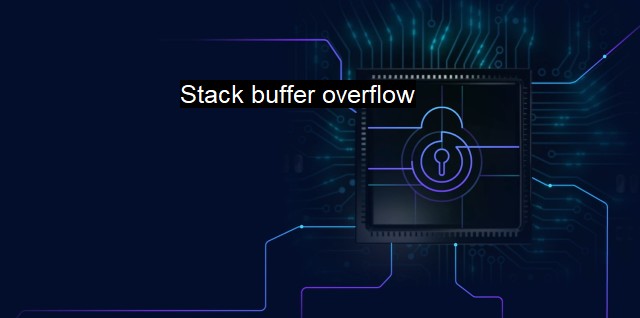What is Stack buffer overflow?
Understanding and Mitigating the Threat of Stack Buffer Overflow Attacks in Cybersecurity: Impacts and Protective Measures
Stack Buffer Overflow defines one of the most critical vulnerabilities in cybersecurity and involves memory overflow issues with buffer, often a volatile storage location on the computer. Specifically, a stack buffer overflow describes a scenario where a buffer, a temporary storage space or register in the CPU, is overwhelmed with more data than it is designed to hold. Requesting the buffer to stock more data than its capacity is what results in the overflow – the surplus data, as input by the potential attacker, spills over to the adjacent buffers and progressively corrupts or directly manipulates the data stored there, compromising the integrity, confidentiality, and availability of information.Typically, buffer overflows have been exploited to allow hackers to gain unwarranted access or privileges to a system, with the menacing capability to execute arbitrary malicious code. Therefore, this vulnerability bears a significant threat level in most operating systems and applications globally.
A stack, theoretically fundamental in computer science, operates on a Last-In-First-Out (LIFO) arrangement. Control data, such as function return addresses, called when carrying out various tasks within a program, are stored in the stack. When buffer overflow occurs on a stack, it overrides such control data. Upon overwritten with malicious data, where control data gets replaced by addresses that point to an attacker's code, there is modification or circumvention of the intended program flow once the function returns.
To better understand the calamity laying in wait with stack buffer overflow, one should note the attacker's objective and procedure. Often, they target embedding arbitrary code into the system, with privileges either of the executing code or sometimes even higher via escalation. First, they would provide crafted input to a vulnerable buffer to exceed its boundaries and destabilize surrounding data. A function's return address can be easily overrun to prevent the system from returning to the initial calling code upon completion, instead directing it towards additional code, such as those the attacker cleverly masked within the tactical input fed to the buffer.
Many unforgiving and high-profile vulnerabilities in the past have resulted from stack buffer overflow exploits, leading to detrimental system security failures, rendering it an issue of righteous concern within security research and improvement movements. Stack buffer overflow has attracted widespread attention within the cybersecurity community, and various proactive and remedial measures have been put in place over time.
These include stringent coding practices that control the amount and nature of data a buffer can hold. Guarding the stack has also been often practiced by programming read-only or non-executable stacks, thus diminishing the potential for exploitation, considering the attacker would no longer be able to write or execute code on the stack. Approaches also feature indicating “canaries” or guard blocks around the return address or crafting stack boundaries, making it more resilient against overflow. A splice in these canaries by an overflow operation gets detected, alerting the program, which can then disable further actions effectively.
To address this perturbing issue at the user-level, several software tools and antivirus programs hold the capability to detect signs of stack buffer overflow in realtime, blocking the suspicious activities and securing the device. Most modern computing environments commonly have inbuilt security measures to mitigate buffer overflow vulnerabilities.
It doesn't strip away the incessant need for vigilance and up-to-date knowledge, as hackers steadily evolve their tricks of the trade. Therefore, it is more crucial than ever to foster continual education and awareness tackling emergent threats while evolving security patterns and tools to stave off the next generation of cybersecurity vulnerabilities. Understanding the core features and mechanisms of the stack buffer overflow vulnerability, its potential exploits, and how they can manifest are surely an important part of that task.

Stack buffer overflow FAQs
What is a stack buffer overflow?
A stack buffer overflow refers to a vulnerability in software code that allows an attacker to overwrite data on the call stack. This can result in the execution of arbitrary code or a crash of the affected program.How can stack buffer overflows be exploited in cybersecurity attacks?
In cybersecurity attacks, attackers can use stack buffer overflows to inject malicious code into a program's memory and execute it. They can also use the vulnerability to hijack control flow and execute arbitrary code.What are some prevention techniques against stack buffer overflows?
Some prevention techniques against stack buffer overflows include ensuring proper bounds checking, using non-executable memory, and using stack cookies. Additionally, using secure programming practices and regularly updating software can minimize the risk of such vulnerabilities.How do antivirus programs protect against stack buffer overflows?
Antivirus programs can protect against stack buffer overflows by analyzing software code and identifying potential vulnerabilities. They can also use heuristics to detect and prevent exploits of known vulnerabilities. Additionally, some antivirus programs use sandboxing techniques to isolate potentially malicious code and prevent it from interacting with other parts of the system.| | A | | | B | | | C | | | D | | | E | | | F | | | G | | | H | | | I | | | J | | | K | | | L | | | M | |
| | N | | | O | | | P | | | Q | | | R | | | S | | | T | | | U | | | V | | | W | | | X | | | Y | | | Z | |
| | 1 | | | 2 | | | 3 | | | 4 | | | 7 | | | 8 | | |||||||